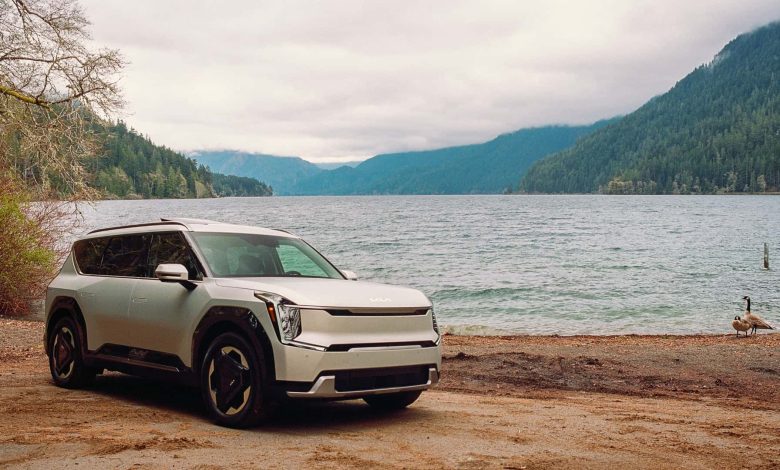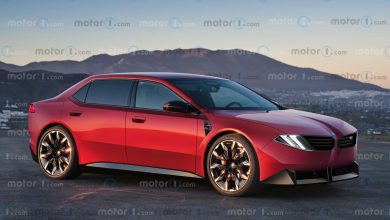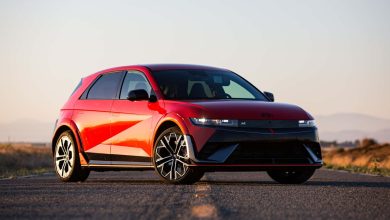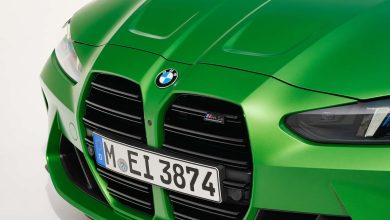The Future Is Bleak. The Kia EV9 Proves It Doesn’t Have to Be

The city of Seattle was an environmental disaster from the moment it was founded in 1851. Its primary industry in the middle of the 19th century was the overzealous logging of 40-story-tall, millennia-old trees. (Its secondary industry was prostitution.)
Seattle’s first sewage system dumped directly into the Puget Sound, and high tide frequently flooded low-lying city streets with raw human waste. In the 1940s, hydrocarbons (and smog) from coal fires reached a crescendo, and massive fish die-offs occurred in Grays Harbor as factories dumped toxic anaerobic runoff into the Pacific Ocean. By the late 1960s, the city of Tacoma semi-permanently reeked of rotten eggs, a byproduct of pulp-plant pollution.
On July 1st, 1970, Washington established the Department of Ecology, the nation’s first environmental agency.
Fifty-four years later, I’m driving 250 miles around the Sound to the Olympic Coast, and without burning a single hydrocarbon. I took five of my friends with me in a three-row electric SUV powered by renewable energy. I vacationed on pristine beaches and walked in preserved ancient rainforests to discover how we built this better world out of the disasters of yore, and what it can teach us for the future.
The Future Is Terrifying
Seeking a better future has long felt impossible for me: I am a millennial. The headlines—ecological and otherwise—have been bleak for my whole life. Since college, I’ve assumed I would have front-row seats to the seemingly inevitable collapse that runaway global warming would precipitate, and the past few years’ violent weather has only reinforced those worries: I’ve personally had to flee life-threatening climates half a dozen times in my life—first from hostile weather, then from hostile politics. It has felt like the walls are closing in, and hope of a better future is rapidly dwindling.
I’m not an aberration. According to Pew Research, most Americans believe climate change is currently hurting Americans, and roughly two-thirds believe the climate will worsen in their lifetimes. A majority are anxious about the future of the planet, but only 38% are optimistic that the problem can actually be addressed. This fear echoes broadly through our society. Polling shows that large majorities of Americans believe the country will be more unequal, less unified, and weaker by 2050.
Americans can seemingly only agree on one thing: We’re headed for a precipice.

How To Escape The Headlines
The women in my car have lived their adult lives immersed in these feelings, for another common trait unites us: We are all transgender. Half of us relocated to Seattle within the past three years to escape the red states we lived in, when the institutional bigotry became too much for us to handle. Before I moved to Seattle, I lived in rural Idaho. I had taken to reading the state legislatures’ bills every day for its entire session, just to ensure nothing suddenly changed in my legal status.
The dire future is not abstract for us. It has already shaped how we live today.
This influenced our choice of locale. Our destination was Kalaloch Lodge, a rustic series of cabins constructed from driftwood perched on the cliffs of the Pacific, at the edge of Olympic National Park. The lodge proudly proclaims on its website that there is no cell signal at Kalaloch, and no internet available in the cabins. The only visible nod to modernization since it was first built in 1953 is a handful of Level 2 EV chargers, provided free of charge for guests with electric cars.
Around the Lodge is nothing but National Park and Forest land, a protected seashore, and an ocean preserve. Notably absent: civilization. We could completely unplug from our phones—and the stress underpinning American life.
We’d earned it.



Choosing A Chariot
It fell to me to find a vehicle suitable for our journey. Options are virtually endless at every price point and demeanor imaginable… unless, of course, you want an electric SUV, where three-row options have stayed scarce, even as Americans grow increasingly accepting of battery-powered vehicles.
And I desperately wanted an electric SUV. A big part of Seattle’s beauty—and what made it the only American city represented in the UN’s Role Model Cities for ecological restoration—is that its power grid is almost entirely clean. 98% of Seattle’s electricity is fully renewable, largely supplied via a series of hydroelectric dams built during the New Deal era. Charging up an electric car in Seattle is as close to living in a post-carbon world as you can get in America, and the Kalaloch Lodge’s chargers promised to make the 200-ish mile journey doable.
There was one other motivation for an electric car. My non-car-enthusiast friends who accompanied me on this journey frequently experience automotive culture as a net negative in their lives. Often, the interests of drivers are pitted against those of the climate (or pedestrians, or transit, etc.), which makes the world of car enthusiasm seem indefensible to them. I wanted to show them that our vehicles could be part of building a better world, and a road trip in a carbon-free SUV felt like the best way to do that.
There are only a handful of options for a three-row electric SUV currently on the market.
There’s Tesla’s Model X, which has an almost unusably small third row, ostentatiously gimmicky doors, and a founder who explicitly hates me and all my friends. I ruled that one out pretty quickly. There’s the Rivian R1S, which has been well-reviewed as a would-be super-SUV competitor, with 1,000+ horsepower variants and sub-three-second dashes to 60.
The Kia EV9 intrigued me for the opposite reason. The EV9 is so normal. While it does carry over some of Kia’s retrofuturistic styling from the smaller EV6 in its front fascia and wild wheel designs, at a glance, it’s not all that different from a gas-powered Telluride.
It doesn’t boast four-digit horsepower or a rock-crawling package. It has three roomy rows and excellent cargo capacity, even when chock-full of passengers. It’s relatively affordable, with a base price of $54,900—dead-on average cost for a new EV. If it didn’t hum instead of rumble, you’d likely never notice it was even an EV. It seemed like the ideal companion for a road trip like this.

The Journey
With an EV9 lined up and our journey set, we headed out towards the coast. The first leg consisted of a ferry ride across the Puget Sound. While it would have been technically possible to take our journey without riding a ferry, it was part of the fun and extremely easy—Washington State Ferries is the largest ferry operating service in America, and its regular service is incredibly scenic. The sparkling waters of the Sound set the tone for the rest of our trip into the unspoiled lands of the Olympic Peninsula.
Our route then took us down the northernmost end of U.S. 101, which encircles the Peninsula. I found the EV9 doing exactly what I desired from it, which was mile-eating comfort for everyone in the car. Some girls slept, some chatted; I kept the (Meridian!) sound system cooly playing 1960s blues and jazz as we snaked through some of America’s most stunning vistas.
The EV9 performed as I hoped it would—stoically composed. As the driver, I found it perfectly acceptable for a three-row SUV; The main things I remember from our drive were my companions, the endless vistas, and the comfy seats, and that’s what I wanted to remember. Kia has not built a vehicle meant to take the spotlight; 1,000 horsepower may grab headlines, but my friends are what I want to focus on during a road trip. The EV9’s silent excellence complements day-to-day living, and it has shown a path forward for electrification in the process.

The sole snag on the journey didn’t come from the EV9 at all, but rather the dire charging infrastructure of America. I planned to stop in Forks, Washington—about 50 miles from Kalaloch—to top up the EV9’s battery, which had roughly 80 miles of charge left on it. While Kalaloch had chargers proclaimed on their website, I couldn’t be certain they’d all be working (or unoccupied). I didn’t want to get a press car completely stranded on the Pacific Coast without any cell service. Luckily, Forks had two sets of DC fast chargers.
Unluckily, that pair was a Tesla Supercharger and a Rivian Adventure Network station. Kia—which has announced a transition to NACS charging ports, but is still using CCS until the end of the year—isn’t including adapters on ‘24 models. I never thought to check this before leaving home and realized my charging-kit bag in the frunk had nothing to help me when I was standing at the Supercharger.
I had read about Rivian opening these once-locked-down DC fast chargers to every EV owner shortly before I embarked on the trip. What I didn’t remember was that those plans were for the back half of 2024. I arrived at the Rivian charger, attempted to plug in and scan a QR code, and the charging station let me know that it wouldn’t be dispensing a drop of juice to my Kia.
One panic attack later, I decided to forge onward to the lodge. Worst-case scenario, we’d make it to the hotel, but go without the car for a day while it trickle-charged on an outlet to give us enough juice to limp it to an actual charger. When we arrived at Kalaloch, I raced to the back of the lot and found the Level 2 chargers. All four were unoccupied, and three of them even worked. Crisis averted—but not before my choice of an EV had shaved a few years off my life from stress.




The Olympic Rainforest and the Satsop Nuclear Power Plant
The rest of the trip proceeded without incident. We visited one of the only unspoiled temperate rainforests on the continent, saw tide pools full of starfish and anemones at Ruby Beach, and had a bonfire together on the shore of the Pacific. It felt like an ideal family vacation; I simply had chosen the family this time.
On the drive home, we stopped at the Satsop Nuclear Plant. Satsop was partially completed in the ‘80s by the Washington Public Power Supply System, but massive cost overruns led to voters pulling the plug before the plant was ever completed. The gargantuan cooling towers and reactor dome still loom over the small town of Elma, Washington; A business park has sprung up in their shadow, but there is no power generated.
When we arrived, it was overcast. The vacant gray landscape and looming towers, ordinarily, would feel post-apocalyptic to me. I’ve written a lot of fiction about the end of the world; It is the main thing I fixate on after a life of running from one hostile place to another, constantly struggling to stay ahead of seeming disaster. But despite the tumult America has experienced over the past decades, there are still pristine beaches. There are still ancient rainforests. I still ran on the sand with my friends. We can preserve these things because we have preserved these things despite all odds against them.



There is work to be done, to be sure. Electric vehicles will not cure our woes magically. But just as the waters of the Puget Sound were not cleaned overnight, America will not find its footing in a single election, charging will not improve without investment, and the way Americans relate to their cars—and move towards electrification–cannot change without effort.What this trip did show me, however, is a glimpse of a world where we can do it. We can still avoid the precipice and we have the building blocks to do it. We just have to keep trying.

39 Photos
Read the full article here








